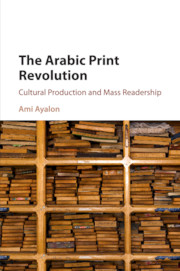Book contents
- Frontmatter
- Dedication
- Contents
- Preface and Acknowledgments
- Introduction
- 1 The Formative Phase of Arab Printing: A Historical Overview
- 2 Printers and Publishers
- 3 Books, Journals, Cartes de visite
- 4 Diffusion Channels
- 5 Advancing Circulation
- 6 Reading and Readers
- 7 Reading in Public
- Conclusion
- Bibliography
- Index
6 - Reading and Readers
Published online by Cambridge University Press: 05 September 2016
- Frontmatter
- Dedication
- Contents
- Preface and Acknowledgments
- Introduction
- 1 The Formative Phase of Arab Printing: A Historical Overview
- 2 Printers and Publishers
- 3 Books, Journals, Cartes de visite
- 4 Diffusion Channels
- 5 Advancing Circulation
- 6 Reading and Readers
- 7 Reading in Public
- Conclusion
- Bibliography
- Index
Summary
Imagine the Egyptian Shaykh Rifāᶜa Rāfiᶜ al-Ṭahṭāwī, who died in 1873, resurrected two or three decades later in his home city of Cairo. Ṭahṭāwī, a highly perceptive observer of human behavior who had spent years in other countries, was certainly a man of the world for his time and place. Still, had he been brought back to life in Cairo in, say, 1900, he would have been mystified by myriad sights and sounds unfamiliar and unimaginable in his own time. Among other phenomena, he would have been baffled by the multiplicity of bookshops, newspaper stands, and street vendors; the city streets being densely inscribed with shop signs, commercial posters, and personal notices; the ubiquity of people reading papers in cafés and elsewhere, silently and vocally; and the sight of money bills, cartes de visite, and tickets of various uses changing hands routinely. Since Ṭahṭāwī's passing away, written items of every form had become standard means for running public systems and for interpersonal interaction. Written messages, of course, can be useful when a significant segment of the people can make them out. And when an area that had been devoid of such signs, like Ṭahṭāwī's Cairo, becomes replete with them in a short time, we may assume a substantial shift in the reading habits of its inhabitants.
The decades around Ṭahṭāwī's passing indeed witnessed the dawn of a major change in Middle East reading, which in time would have far-reaching ramifications. The practice may have been on the rise among certain groups in Egypt, Syria, and Lebanon already prior to the nineteenth century (see Chapter 2), but now the change was markedly enhanced. An analogous transformation in reading habits had occurred during the eighteenth and early nineteenth century in parts of Western Europe and the United States, following a series of social and cultural developments: the accelerated spread of education, the expansion of publishing, and the burgeoning of various access channels. They entailed not only a swelling of the readership but also changes in reading patterns and in the read materials themselves. A reflective focusing on a limited selection of texts, often of religious-spiritual or literary nature, gave way to a lighter, more cursory browsing of writings of many types, including works of ephemeral substance that were becoming more affordable.
- Type
- Chapter
- Information
- The Arabic Print RevolutionCultural Production and Mass Readership, pp. 154 - 176Publisher: Cambridge University PressPrint publication year: 2016

